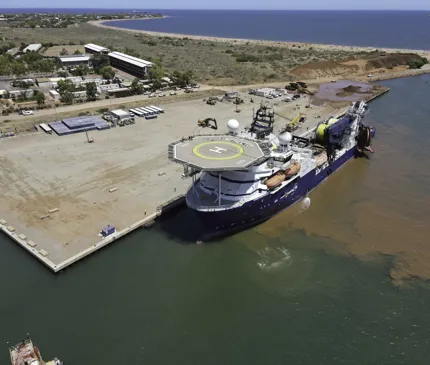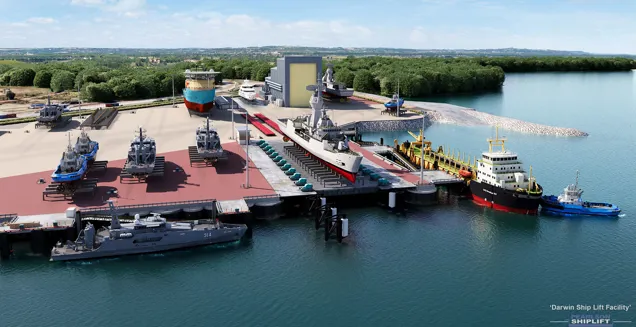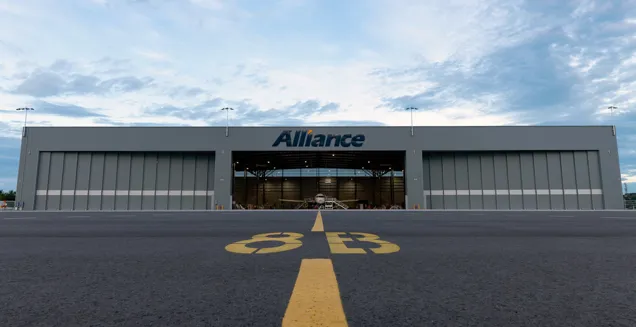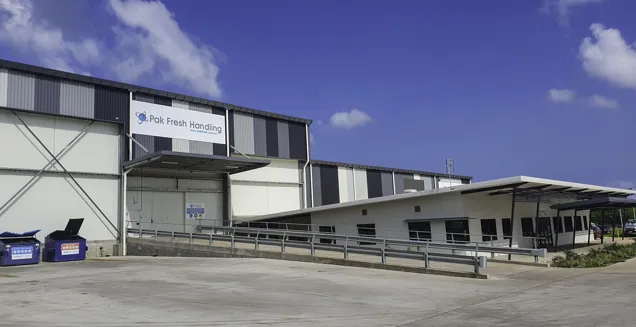Onslow Marine Support Base
Explore NAIF's vital role in accelerating the Onslow Marine Support Base project, driving economic growth and job opportunities in Western Australia.
September 2017
Transport & Logistics
Onslow, WA

Onslow Marine Support Base (OMSB) is a logistics hub nestled in Onslow, Western Australia. NAIF financing played a pivotal role in expediting the project's comprehensive scope, making an immediate impact and unlocking Onslow's potential.
About the Onslow Marine Support Base
The Onslow Marine Support Base is a pivotal facility catering to the needs of diverse offshore industries, with a primary focus on the oil and gas sector.
Operating as a vital port and logistics hub, the support base serves as a central point for the transportation of personnel, equipment and essential supplies to and from offshore facilities.
Its comprehensive range of services ensures seamless operations and plays a crucial role in bolstering the activities of the offshore energy sector within the region.
Project Overview
The OMSB facility upgrade encompassed several key components, such as a wharf, training wall upgrade, and expansion of the inner/harbour channel. This expansion project involved capital construction for both the channel and turning basin.
This multi-user facility serves as a comprehensive resource, offering chandlering services, heavy lift capabilities, reverse logistics support, refuelling options, transportation solutions, freight services, and emergency assistance. Its primary purpose is to provide essential support to onshore and offshore industries operating in the middle and southern regions of the Carnarvon Basin.
How We Helped
NAIF’s support helped unlock the full economic potential of the Onslow Marine Support Base Expansion Project by overcoming depth limitations that restricted the range of vessels able to be serviced. With NAIF finance in place, all vessels supporting the offshore oil and gas industry in the region can now access the new base, delivering greater efficiency and strengthening northern Australia’s marine capability.
This financing was integral to the immediate delivery of the full project scope, accelerating outcomes by three to five years. NAIF provided concessional finance with a risk appetite that complemented private lender National Australia Bank, enabling a partnership that de-risked delivery and encouraged private co-investment.
Through this support, the Onslow Marine Support Base Expansion has been brought forward years ahead of schedule, enhancing regional economic growth and providing critical servicing capacity for northern Australia.
Public Benefit
The Onslow Marine Support Base project is expected to yield substantial economic benefits for Western Australia, with a projected $100 million benefit over a 10-year period. This includes a notable 45% increase in the local Gross Regional Product compared to the figures from the 2011 census. These economic advantages are also expected to extend to the broader Onslow and Ashburton communities.
In terms of employment, the project estimates that it will create 61 jobs during the construction phase and 166 jobs during its operational phase. This represents a significant boost to the local workforce and economic activity.
Furthermore, the facility is anticipated to deliver significant advantages in terms of productivity, time efficiency, and fuel savings, ultimately reducing costs for local operators and mitigating operational risks. Additionally, it will help retain and capture services that might otherwise be outsourced overseas.
NAIF has been instrumental in allowing the OMSB project to progress far quicker and unlock the strategic location of Onslow, which will provide efficiencies that will promote jobs and further opportunities to the state of WA.

Andrew Natta
Executive Chair, Onslow Marine Support Base
Related Links
Indigenous Engagement
- The Thalanyji people
Thalanyji Country stretches across the southwest Pilbara and Gascoyne regions of Western Australia, spreading across the Ashburton River coastal plain south to Tubridji Point, then across to Yannarie River and upstream to Emu Creek, across the range hills of southwest Pilbara to Henry River and Cane River in the north. Thalanyji people share kinship and cultural ties with neighbouring groups throughout the Pilbara and Gascoyne, forming a vast social network that links cultural knowledge across Australia. Today, Thalanyji people continue to maintain a strong cultural presence in the Onslow region, contributing to local community, environmental stewardship, and regional development. The Buurabalayji Thalanyji Aboriginal Corporation (BTAC) represents the Thalanyji Traditional Owners, managing Native Title interests, promoting cultural heritage protection, and creating pathways for economic participation, employment, and business opportunities that reflect the aspirations of the Thalanyji people.
Indigenous Engagement Strategy Commitments
- Acknowledge Thalanyji Traditional Owners at formal events, develop cultural protocols and strategies to build their cultural competency to operational staff in collaboration with BTAC.
- Committed to building a strong, direct relationship with BTAC at both executive and board levels, with regular engagement to support Thalanyji economic and social priorities.
- Actively engage with First Nations suppliers, contractors, and businesses that employ local First Nations workers, and encourage its stakeholders to adopt First Nations employment strategies where feasible.
- Explore local sponsorship and partnership opportunities, such as supporting Onslow Primary School programs, and review its Indigenous Engagement Strategy annually in consultation with stakeholders to ensure continuous improvement.
Indigenous Engagement Strategy Outcomes
- In 2018, Onslow Marine Support Base (OMSB) established partnerships with the Thalanyji Traditional Owners and the Buurabalayji Thalanyji Aboriginal Corporation (BTAC), with the aim of supporting economic development opportunities such as the leasing of Thalanyji-held industrial land. First Nations employment accounted for 5.3% of total project hours.
- In 2019 and 2020, OMSB revised its Indigenous Engagement Strategy (IES) in collaboration with BTAC to reflect new opportunities linked to the project and growing industrial activity. However, the progress of both the project and the IES was significantly impacted by COVID-19 restrictions.
- In 2021, OMSB executed a new Memorandum of Understanding (MoU) with BTAC, aiming to develop the Onslow Logistics Hub. Although First Nations employment and contracting were limited during this period, a key milestone was the servicing of the first Platform Supply Vessel (PSV), and planning commenced to include BTAC in long-term port development opportunities.
- In late 2021 and early 2022, OMSB awarded a significant contract to BTAC-owned business Kuuwa for the leasing of civil equipment and engaged local First Nations business BriJarCass for cleaning services.
- In 2023, OMSB broadened engagement with First Nations businesses, including Kuuwa and BriJarCass, and partnered with a First Nations labour hire company. OMSB also updated its IES to reflect the transition of the project into operations.
- In 2024, OMSB continued engagement with BTAC and reported that 13.4% of total vendor spend was with First Nations businesses, while First Nations employment reached 8%. OMSB invested in local talent through its support of Onslow School’s workplace learning program, and continued delivery of its Reflect Reconciliation Action Plan (RAP), progressing towards the Innovate phase.
- As of 30 June 2025, OMSB fully repaid its loan, as such there are no further reporting obligations to NAIF under their Indigenous Engagement Strategy (IES), however, the project will continue to generate jobs and long-term economic benefits for the region.


